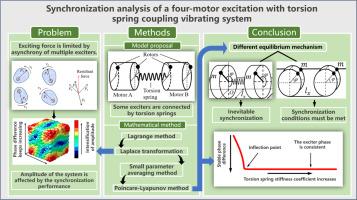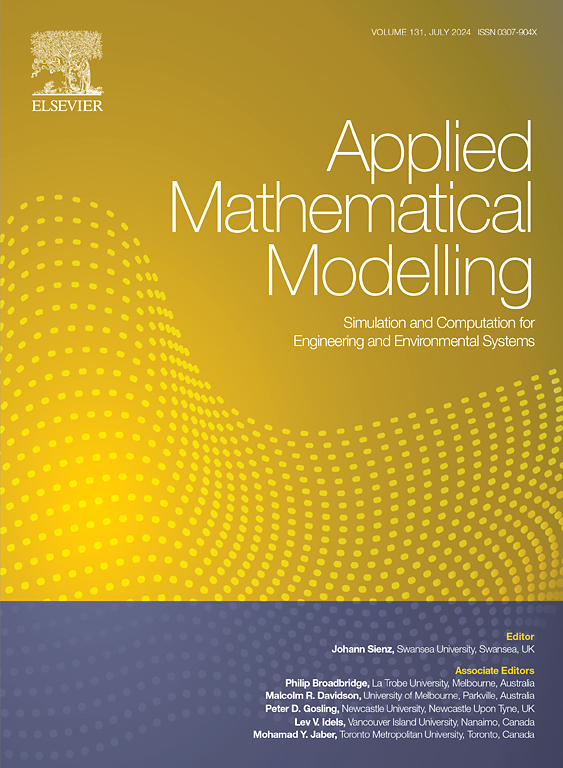Synchronization analysis of a four-motor excitation with torsion spring coupling vibrating system
IF 4.4
2区 工程技术
Q1 ENGINEERING, MULTIDISCIPLINARY
引用次数: 0
Abstract
In oil drilling processes, vibrating screen is a crucial solid control equipment for separating harmful solid-phase particles. However, the conventional utilization of either dual-motor or triple-motor is inadequate demanding the excitation force of large vibrating equipment. Moreover, self-synchronization in zero phase is difficult to achieve in multiple motors system. To avoid cancellation of the excitation force caused by the phase inconsistency of multiple motors, the adoption of a four-motor excitation with torsion spring coupling system is proposed this work. Initially, the mathematical model of the vibrating system is formulated through the Lagrange's equation. Subsequently, the steady-state solution is determined using Laplace transform. Then the conditions and characteristics in stable equilibrium state are elucidated employing the small parameter averaging method. Ultimately, the reliability and applicability of the theoretical results are substantiated through numerical simulations. The findings reveal that with the increase of the torsion spring stiffness, the phase difference between the motors connected by torsion springs (MCTSs) is exponentially decreased, and desired zero-phase synchronization in engineering is eventually achieved. Furthermore, the present study uncovers two distinct synchronization mechanisms in the torsion spring coupling system: mechanical controlled synchronization between MCTSs is inevitably achieved, while the self-synchronization between motors unconnected by torsion springs (MUTSs) is limited by the synchronization conditions. The study provides valuable insights for designing mechanical controlled synchronization and self-synchronization vibrating machines.

带扭簧耦合的四电机激振振动系统的同步分析
在石油钻井过程中,振动筛是分离有害固相颗粒的重要固控设备。然而,传统的双电机或三电机系统无法满足大型振动设备的激振力要求。此外,多电机系统很难实现零相自同步。为避免多电机相位不一致造成激振力抵消,本研究提出了采用扭簧耦合系统的四电机激振系统。首先,通过拉格朗日方程建立振动系统的数学模型。随后,利用拉普拉斯变换确定稳态解。然后,利用小参数平均法阐明稳定平衡状态下的条件和特征。最后,通过数值模拟证实了理论结果的可靠性和适用性。研究结果表明,随着扭转弹簧刚度的增加,通过扭转弹簧连接的电机(MCTS)之间的相位差呈指数级减小,最终实现工程中理想的零相位同步。此外,本研究还揭示了扭簧耦合系统中两种截然不同的同步机制:MCTS 之间必然实现机械控制同步,而未通过扭簧连接的电机(MUTS)之间的自同步则受到同步条件的限制。这项研究为设计机械控制同步和自同步振动机械提供了宝贵的启示。
本文章由计算机程序翻译,如有差异,请以英文原文为准。
求助全文
约1分钟内获得全文
求助全文
来源期刊

Applied Mathematical Modelling
数学-工程:综合
CiteScore
9.80
自引率
8.00%
发文量
508
审稿时长
43 days
期刊介绍:
Applied Mathematical Modelling focuses on research related to the mathematical modelling of engineering and environmental processes, manufacturing, and industrial systems. A significant emerging area of research activity involves multiphysics processes, and contributions in this area are particularly encouraged.
This influential publication covers a wide spectrum of subjects including heat transfer, fluid mechanics, CFD, and transport phenomena; solid mechanics and mechanics of metals; electromagnets and MHD; reliability modelling and system optimization; finite volume, finite element, and boundary element procedures; modelling of inventory, industrial, manufacturing and logistics systems for viable decision making; civil engineering systems and structures; mineral and energy resources; relevant software engineering issues associated with CAD and CAE; and materials and metallurgical engineering.
Applied Mathematical Modelling is primarily interested in papers developing increased insights into real-world problems through novel mathematical modelling, novel applications or a combination of these. Papers employing existing numerical techniques must demonstrate sufficient novelty in the solution of practical problems. Papers on fuzzy logic in decision-making or purely financial mathematics are normally not considered. Research on fractional differential equations, bifurcation, and numerical methods needs to include practical examples. Population dynamics must solve realistic scenarios. Papers in the area of logistics and business modelling should demonstrate meaningful managerial insight. Submissions with no real-world application will not be considered.
 求助内容:
求助内容: 应助结果提醒方式:
应助结果提醒方式:


